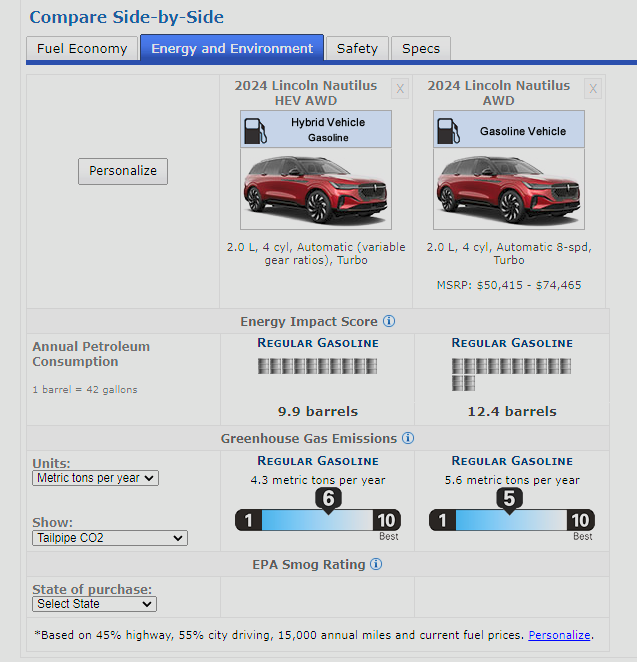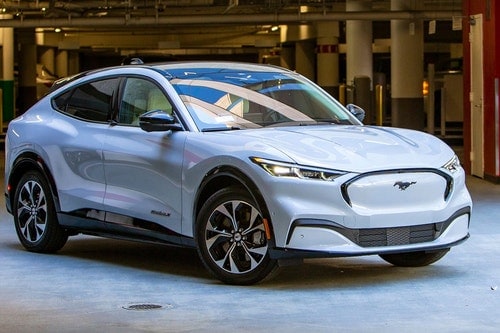-
Posts
24,561 -
Joined
-
Last visited
-
Days Won
110
Content Type
Profiles
Forums
Gallery
Downloads
Store
Posts posted by silvrsvt
-
-
4 hours ago, Rick73 said:
That’s not a given, or a fact. Repeating this assumption doesn’t make it so. I’m replying here solely for benefit of others.CVT don't work for towing applications like this engine would be required to be doing...that is my response to that. It might work in a light duty application, but it won't for vehicle that needs to tow or haul things.
-
I'm guessing the "headlights" are the tall light bars on the side of the fascia? It looks weird.
-
3 hours ago, Rick73 said:
Other than designing a gas version of Power Stroke diesel V8, a lower-cost option may be a +/- 6-liter EcoBoost twin-turbo V8. Maybe Ford could resurrect the long-stroke tall-deck Modular V8 to make a new truck-specific engine. That same architecture minus turbos could also serve as naturally-aspirated engine for large hybrids, thereby spreading cost over greater volume. Even if possible to design a long-stroke Coyote-based EcoBoost V8 for trucks, I doubt it would be considered. It would likely compete well on power, torque, fuel economy and cost with new Cummins, but perceived ruggedness and durability would not be competitive in my opinion.
Given the fact that hybrids don't really improve gas mileage in larger engines, I don't think that is going to happen anyways.
-
4 hours ago, akirby said:
That changes nothing I said. Did you look at the two examples I gave for fuel consumption of two vehicles that were plugged in every night?
Because the data being collected actually shows when the vehicle is actually charged
https://green-driving.jrc.ec.europa.eu/JRCmatics_Monitoring_Fuel_Consumption_from_OBDQuoteand lifetime parameters from OBFCM:
- Total driven distance (km)
- Total fuel consumed (L)
- Total energy recharged from the electrical grid (only Plug-in Hybrid vehicles)
-
On 4/5/2024 at 2:10 PM, akirby said:
No it doesn’t address my scenario at all. Those studies only look at WLTP predictions vs measured overall fuel economy. It does not take into account how many miles are being driven on a daily basis (nor can it because that data is unavailable). They’re only measuring total miles driven vs fuel used.I just gave you 2 examples of hugely different mpg for 2 different vehicles that both get fully charged every night. Without knowing the background the study would conclude the vehicle only getting 42 mpg was not being plugged in. But that is 100% false.
You cannot use observed mpg to determine if a vehicle is being plugged in without knowing how many miles are driven each day. Period. It’s simple math.
Well read this then:
https://climate.ec.europa.eu/document/download/b644dafe-1385-4b56-98d9-21e7e9f3601b_en?filename=report.pdfQuote2.1. Data sources and data processing According to Implementing Regulation (EU) 2021/392, real-world data must be collected by both vehicle manufacturers and Member States and reported to the European Environment Agency (EEA). Manufacturers may rely on data transfer over-the-air directly from the vehicle or collect this data through their authorised dealers or repairers when vehicles are brought in for service or repairs. Member States have been required to collect the real-world data during roadworthiness tests since 20 May 2023. This first report is based on the real-world data collected by vehicle manufacturers throughout 2021 on their cars and vans equipped with OBFCM devices.
OBFCM: On-Board Fuel Consumption Monitoring
-
-
38 minutes ago, akirby said:
I think they’ll keep Lightning in some capacity for Ford Pro customers.
But depending on who you believe, the lightning might not be selling to them either.
I'd think that Ford wouldn't want to divide the market for something that doesn't sell that well. -
5 hours ago, Oac98 said:
Blueovalcity product launch is 2026, as for us at Oakville there ain’t a damn thing we can do but go into contingency mode.
I don't see much happening to BOC outside of maybe a delay or two with product. I think Ford winding down the Lightning production is telling also, since I don't expect the Lightning to stick around once the new EV truck is in production.
Also I see other plants maybe getting shut down in NA (like Flat Rock) later this decade with the product going to BOC as the EV transition goes on.
-
22 hours ago, akirby said:
It is possible they decide to bring back Nautilus and design a new C2 edge for Oakville. They could even move Corsair and Escape if they need space in Louisville for the new cheap EVs. They can still use the Canadian batteries for hybrids.
I just don’t see the 3 row EVs fitting into Ford’s future plans at this point.
But how would that affect the benefits they've gotten from the Canadian government?
-
Different bumper...not sure what else has changed on it. Hopefully maybe a move to a 800V system so it can charge faster.
-
14 minutes ago, akirby said:
We know exactly what it means and that was already stated. It means the WLTP estimated fuel economy is not an accurate prediction of real world fuel consumption based on samples. And the PHEV estimates are wildly optimistic.QuoteThe main differences between the EPA and WLTP EV range ratings boil down to the lab temperature and the EPA recording the actual number of miles driven, which is then adjusted by multiplying it by 0.7. By contrast, the WLTP produces its ratings by a more complicated mathematical formula which is not adjusted.
https://insideevs.com/features/695492/epa-vs-wltp-ev-range-difference
6 minutes ago, akirby said:And let’s reiterate the flaw in simply measuring PHEV fuel consumption to conclude that they aren’t being plugged in.
Let’s say my escape PHEV can go 30 miles on battery and gets 35 mpg afterwards and let’s say I charge fully every night.
If I only drive 40 miles per day I use about 1/3 of a gallon. Thats 120 mpg.
If I drive 210 miles per day I use about 5 gallons or 42 mpg.
Just looking at fuel economy one might conclude that one is being plugged in and the other isn’t and that’s completely untrue.
Another example of lies, damn lies and statistics.
QuoteFor the new plug-in hybrid electric cars registered in 2021, the average real-world CO2 emissions (139.5 g CO2/km) were only 23% lower than for conventional cars (180.3 g CO2/km), and 3.5 times (100 g CO2/km) higher than what the WLTP test indicated (39.5 g CO2/km) – see Figure 1. For those vehicles, the calculation of their WLTP fuel consumption and CO2 emissions takes into account a utility factor, which is the expected share of distance driven in electric mode. On the road, the CO2 emissions of those vehicles will depend to a great extent on the real share of distance driven fully electrically, which in turn depends on the actual recharging and use patterns, and specific vehicle technologies. The large discrepancy found for these vehicles between the real-world and the WLTP values shows that they are charged and driven in electric mode much less than how they were expected to be used and that assumptions used for calculating the WLTP test result do not hold in real-world conditions.
So the study already addressed that part...WLTP is just a baseline test but the expected difference in the "real world" was quite a bit more then it should be. The difference in ICE was 21% vs an expected 20%
-
3 hours ago, akirby said:
And you just keep ignoring the 25% reduction in co2 even when it’s not being plugged in.
I'm not, the various governments apparently don't think that enough or they would say hey its ok if you just make hybrids, instead for pushing the market towards ultra low or no CO2 emissions vehicles (PHEV or EV).
-
1 hour ago, Texasota said:
This clearly illustrates you do not understand the purpose or rational for PHEVs. They were never intended to be plugged in all the time and driven 100% in EV mode. They are excellent at being driven 100% in EV mode for shorter city trips and commutes. They are also excellent for long highway trips which BEVs are currently not. During my recent three day highway trip to my snowbird location I averaged over 40 MPG (no charging). While driving in my home town I'm always in EV mode and no gas is burned.
Again, you are either unable or unwilling to understand the point of PHEVs. I'm confident the majority of PHEV owners are using them exactly the way their manufacturer intended. After all, they paid a premium for them. I assure you that I am using my PHEV properly.
The issue is that your using your own experience as gospel for everyone else, when the data obliviously is contradicting that, not to mention just basic human nature for not knowing any better or not even caring when using a car.
You also missed the point, that in the eyes of the government and its regulations and what the manufacturers are doing to meet them, by using PHEVs, they aren’t as effective from reducing a CO2 perspective as they where thought to be, because a significant amount of people aren’t using them properly.
As for plugging in-they are tested to be plugged in to get the max efficiency out of them. Average driving distance is roughly 30 miles a day, which using the Escape PHEV, a single charge can do or at least use its ICE to a bare minimum. Otherwise your burning some fuel to get where you need too.
-
1 hour ago, Harley Lover said:
I guess this means the model that we've seen covered in the spyshots (the 3 row vehicle) that has gotten woeful feedback in consumer clinics has been consigned to the scrapheap, and Ford is doing a full on redesign/greensheet with lessons being learned from the skunkworks project currently underway.
Nah I wouldn't go that far, maybe a restyling or other improvements. The Skunkworks was about making an more affordable EV that would be around Escape sized.
-
7 minutes ago, 7Mary3 said:
The point is to get away from ICE's. Hybrids still have ICE's. Hybrids, plug-in or otherwise, therefore are not the solution. The recent increase in hybrid interest is driven by current consumer reluctance to buy BEV's and auto manufacturers wanting to recoup ICE costs in danger of eventually becoming 'stranded'. While I believe it is true that many of our elected (and otherwise) officials and environmental advocates are pushing the BEV mandate faster than is technically and economically feasable, it is very clear that BEV's are the long term solution to clean and efficient ground transportation.
Thanks for summing up what I was unsuccessfully trying to get out

-
32 minutes ago, akirby said:
If you’re trying to say those reductions aren’t significant then there is no point continuing the discussion.
They are insignificant if you use a properly charged PHEV or EV in comparison. Since both of them can produce less then .5 metric tons of CO2 a year.
-
3 minutes ago, akirby said:
And do not say “Here’s the thing”……. 😂
LOL
But your comparing MPG to CO2, which is what the article is about 😛
And don't forget that MPG doesn't linearly get better either as it goes up.
-
10 minutes ago, akirby said:
I give up. Hybrids are terrible and plug in hybrids are more terrible. Go it. Move on.Did I ever say that? The only point I was addressing is that they aren't as clean as they are made out to be because people aren't using them properly, so at that point what is actually the point of it?
Manufactures are building P/HEVs because they need to make CO2 requirements due to government, but customers are not using them properly to get that benefit and what it defaults to isn't a major improvement over ICE in the same product.
-
5 minutes ago, akirby said:
But for those who DO plug in the savings are huge.
but apparently the data is stating they are not.
-
2 minutes ago, Flying68 said:
I did notice in the EU document that they will be examining the factors used in the WLTP test and regulations for PHEVs. I wish they would also examine how far off the WLTP is from real world usage on BEV's as well. It is widely understood that the WLTP range numbers for BEV's is pure fantasy, they are even more optimistic than EPA range numbers. All these regulatory testing protocols would benefit from an update that reflects real world driving cycles.
The issue is that laboratory testing needs to be done at a fixed constant, which why there is a difference.
EPA Vs. WLTP EV Range Ratings: Here’s Why They’re DifferentNot to mention that EPA Fuel Economy tests are off themselves, I can get almost 20 MPG with my Bronco without trying with local driving, which is bit better then the city rating for it. On the high way I'm lucky to get 20 MPG, because its a brick LOL
What it boils down to is EPA Fuel Economy/range and WLTP ratings are a baseline, not a guarantee
-
2 minutes ago, Flying68 said:
So the articles make it sound like PHEV's are bad for the environment, when in reality what the data actually shows is that the regulatory testing for PHEV's is flawed and the real world implementation of the plug-in doesn't match what expectations are. This all goes back to a fundamentally flawed emissions cycle that also affects range publication for BEV's. The testing cycle has too much low speed, low acceleration in it, where as real world city driving is faster acceleration to higher speeds with greater deceleration, mixed with periods of long idling and some highway driving. The highway test still uses lower acceleration to 60 mph where most commonly people are using 75% of throttle to accelerate to 70 mph with 75 mph being a common interstate highway speed.
PHEV's are just like regular HEV's in terms of CO2 emissions when people don't plug them in, and may be worse depending on the extra weight being carried around from the larger PHEV battery vs a normal HEV battery. I wish our '24 Nautilus that is on order would have been a PHEV, but am satisfied with it being just a HEV.
Looking at the source article, ICE had about 20% variance from laboratory testing (which was expected by them), but PHEVs where significantly worse then their testing, which was deducted down to them not being plugged in all the time.
What it ultimately boils down to is that PHEVs don't really offer a huge improvement in CO2 emissions unless they are plugged in all the time, which was the primary reason why they are being implemented.
Then add in the fact that larger vehicle hybrids offer almost no improvement over a smaller gas engine (ie F-150) in CO2 emissions either
-
Your images are broken
-
32 minutes ago, T-dubz said:
Edge sales are crazy. It’s selling almost as much as the escape and it’s a 100 year old design. Rebates are surprisingly low at only $1500 too. Wonder what sales would be like if ford refreshed the sheet metal? Interior just needs an update to ford’s current switchgear and steering wheel along with a new seat and dash design.
I was wondering where all of the sales were happening at because I haven’t seen any edges on dealer lots around me and haven’t noticed any new ones on the road, but I’d guess it’s a big seller up north where awd is more important.
standard awd, huge touchscreen, good amount of tech, and a moderately low price make it a pretty compelling option.
The reason it is selling so well is that its getting subvented interest rates....even at 84 months, its 1/2 of a "good" rate from a Credit union.
-
2 hours ago, akirby said:
That’s a 25% improvement. Times millions of vehicles sold per year. Yes, that’s quite significant.
But there isn't millions of P/HEV being sold yet and its "only" 25% improvement...when other tech out there offers a larger improvement.





Cummins 6.7 Gas
in Ford Motor Company Discussion Forum
Posted
The problem is that you have all that extra weight in the engine block that isn't necessary for gas engine due to the lower compression ratios. I'd also venture to guess that the setup for the heads for a Diesel and Gas engine could be quite different also, depending on what they use.